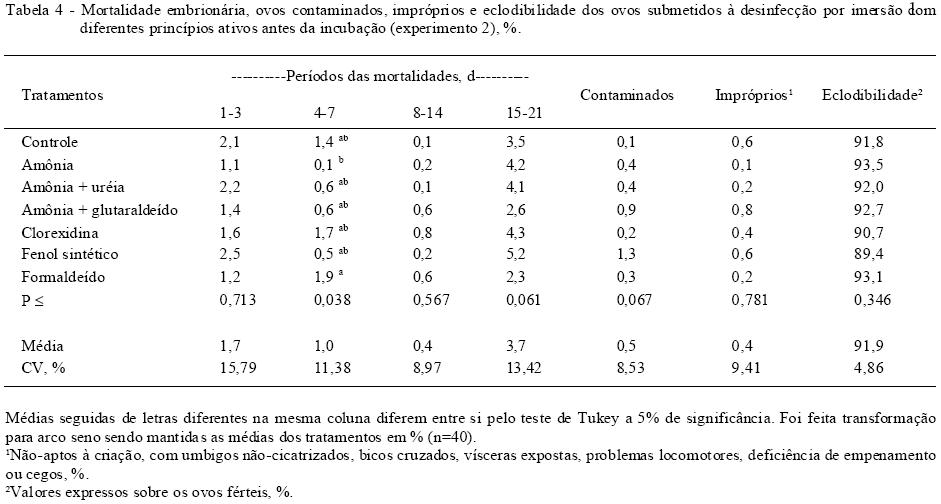Two experiments were conducted with the objective of evaluating different active compounds and methods of egg disinfection. In the first experiment, disinfection was done through spray whereas in the second it was done using immersion. Disinfections were performed at breeder house immediately after laying. In both experiments there were five treatments using the following disinfection solutions for each method: synthetic phenol (1040ppm), chlorexidine digluconate (200ppm), quaternary ammonium (800ppm), quaternary ammonium (400ppm) + urea (600ppm), quaternary ammonium (130ppm) + glutaraldehyde (370ppm). In both experiments there were a control treatment without disinfection and another using disinfection using fumigation with formaldehyde (7.7gm-3). After the disinfection procedures, forty eggs per treatment were evaluated for presence of total mesophiles, mould and yeast, total coliforms, Pseudomonas sp and Aspergillus sp. Embryo diagnosis was driven in no hatched eggs, for determination of embryo mortality period, interior contamination, and it was determined the birth of inappropriate chicks for rear and hatchability. In the experiment in that eggs were disinfected by pulverization, the association between ammonia and glutaraldehyde presented higher contamination for total mesophiles in relation to other treatments, with exception of synthetic phenol treatment, which presented similar contamination to all. Differences were not detected among treatments for mold and yeast, total coliforms, Pseudomonas sp and Aspergillus sp, and for embryo diagnosis results. In experiment in that eggs were disinfected through immersion, higher contamination was verified to total mesophiles in eggs no disinfected in relation to disinfected with the different active components. Eggs without disinfection also presented larger contamination for total coliforms in relation to ammonia and urea treatment, being similar to all other treatments. The analysis of mold and yeast contamination, Pseudomonas sp and Aspergillus sp showed similar results among treatments. Eggs disinfected with formaldehyde had higher embryo mortality, in the period from 4 to 7 days, in relation to those disinfected with quaternary ammonia, being other treatments similar to all. In general, the studied disinfectants presented action capacity in the reduction of microbial contamination of incubated eggs. All disinfectants also demonstrated to be safe to survival of the embryos, without great restrictions.
disinfectants; disinfection; eggs; embryo mortality; hatchability




